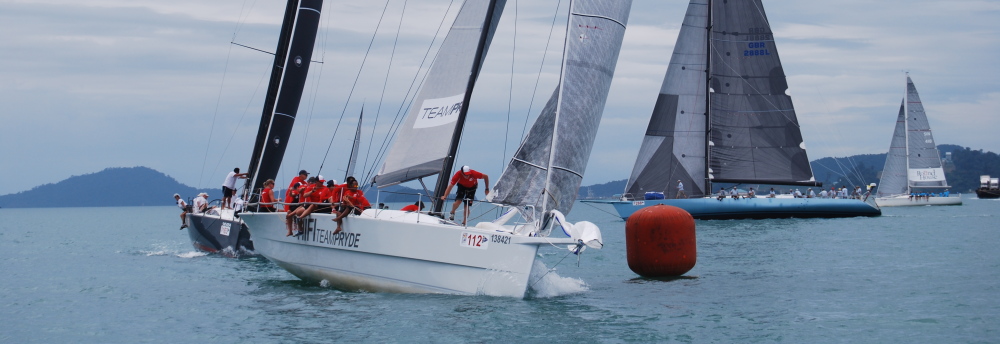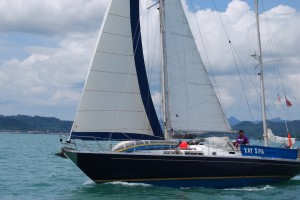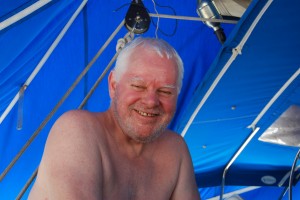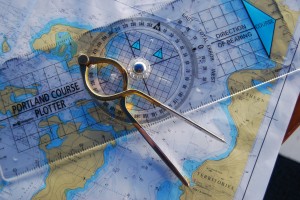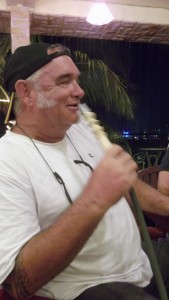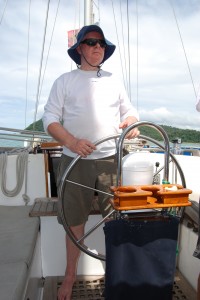Authority afloat emanates outwards from self like the relationship of tree trunk through boughs to twigs and foliage. If the trunk is sound the rest of the tree can thrive, as the material of the ship and its crew can be nurtured and controlled by the skipper. As from the sub-conscious, there is a ground source of sustenance in the skipper from which the sap arises. It feeds the limbs and leaves, enabling their reciprocal contribution; the employment of the cunning that drives the ship safely and quickly to landfall.
My first short spells of command were assigned whilst cruising in Lankawi waters. We pootled about and found a safe anchorage one night hard against an island with a face. Here is part of the general setting, in a tiny jungle-covered archipelago offering shelter from the expected North-East winds; although contrary winds can blow.
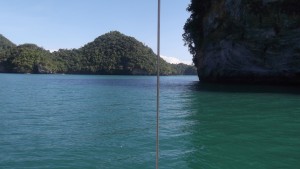
Rejecting a hollow island in this group that houses a million bats, it was the weathered face of this one where the snuggest spot was found.
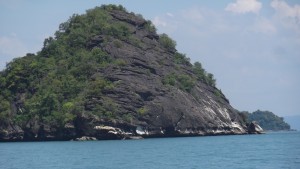
Next morning I had to plan my first tiny voyage from here through a narrow and difficult sound to a depth line from which my opposite number training like me for RYA Day Skipper could take over.
There were so many things happening at once. My uncertain navigation skills tottered on their legs like a new-born calf. The extra responsibility for ship and crew on passage on these inshore waters of danger was crushing and I felt the full weight of it as I desperately tried to answer the well-placed questions posed by the instructor.
“On which side is the safe depth of water?”
“How do you know when to turn?”
Causing a safe and a good course to be steered is initially an effort of will that created within me such a heat of anxiety that I held back a torrent of blind words that threatened to outflow like lave from a tortured volcanic cone.
I managed this, with the help and guidance of the instructor, and on reflection I was already beginning to need that essential humility without which no man can call himself a seaman. A humility that accepts the ignorance of complete information and honestly acknowledges it.
This process of commanding brings intense delight, yet is full of fears. The next morning we continued our practice in the broad waters of Bass Harbour, where our sister ship, beloved Kay Sira. often flaunted herself majestically, like this.
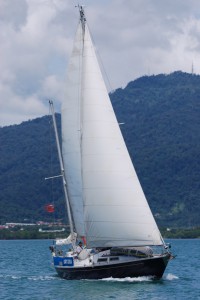
I hope I have explained that this week I have been assigned to Aeolus the second of the three school boats in which I have served.
Slipping our moorings that same night at 11pm, after an afternoon reset at the marina, we sailed for Penang, 60 miles south, after a violent rainstorm.
I took command at the historic landfall known to the ancient Indian sailors seeking forest products in exchange for cloth and iron tools, the mighty Kedah Peak (Malay: Gunong Jerai).
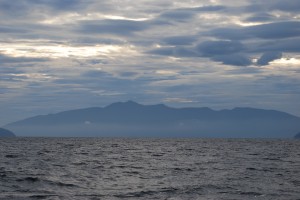
I have waited all my life to make this landfall. This mountain broods over the Penang of my youth. Its face, subtly changed in aspect as seen from my childhood home, was captured in oils by my mother and now hangs in my office at home with a rejected study unfinished below.
And now I was using the wireless masts at the peak as a component of an excellent three-point fix, the first in which I had full confidence. In the seas below there are four islands, nicely angled, laying the navigator’s task out for him as an excellent butler disposes a table for dining. In the shot above you can just see the edge of one of these: Pulau Bunting. Here is the massif of the Gunong taken with the telephoto lens.

And here is another of the islands, Pulau Telor (Malay: Egg Island), ditto.
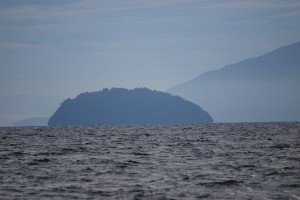
There was still over a third of our voyage to go. I went off watch and rested, only to be told when I emerged again, by a grey-faced instructor (he had hardly slept at all because his skippers were so new):
“I am feeling unwell. I must go and lie down, will you take command?”
It was like a body blow. I gulped and nodded, and after a glance all round the horizon, I rushed below to establish our position exactly, using GPS for the first time (in sorrow rather than in anger). When I had determined this, and with some satisfaction concluded that I did indeed know where we were. I could confirm the GPS by bearings on Gunong Jerai, a convenient island in that chain, and the south eastern headland of Penang itself.
I was surprised to see Simon our instructor still quietly sitting in his favourite place with his back on the man-overboard kit. And then it dawned on me: it was a trick and I had been fooled! Good lesson! I had done the right thing.
Bringing the ship into the know waters of Penang roads revealed the excresence of high rise building new from my youth.
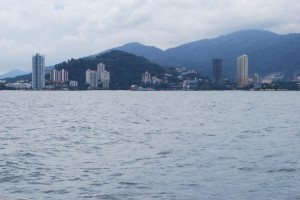
And now my greatest failure to date occurred. Willingly relinquishing command for entering the Straits Quay Marina (a picture of which forms one of the banners of this blog), I was ordered to drop the mainsail, and I asked another crew member to assist me. I tried to explain how to do the ‘flaking’ procedure which folds the sail in loops over the boom to the colleague, but either due to failure to make myself clear, or perhaps due to a deliberate sabotage, his end of the operation was sloppy, messy, and insecure. His end of the sail was all ruckled and his ties so loose that all the flakes collapsed in a heap on one side of the boom. Running backwards in my temper I pulled up one of his ties and shouted:
“Look at this – loose as a girl’s knickers! Get this tightened up you bugger! Look! Like this!”
The poor man, loaded with his own particular incidental pains, was all fingers and thumbs and I became at that instant his mortal enemy. I had utterly failed in the human relations department, and the heady wine of my new-found pretensions to be a skipper turned to a sour and undrinkable corkage. ‘I will never be able to take command’, was my over-reactive thought, for I will always be undone by my anxiety so that I cannot inspire people to follow me. My fifty years of seamanship in small boats, my new found navigation skills are all as nothing if I can only, like Captain Bligh, excite the hatred of my fellow man, turning his joy to mutiny, his effort to dumb insolence, and his aspiration to failure.
Ach, it was a bitter blow for the new skipper, and the fall from grace magnified. It was not quite like that imagined by Milton:
‘Nine days he fell, from dawn to dewy eve’
But nonetheless I arrived at my ‘own place’ in hell, at ‘bottomless perdition, there to dwell in adamantine chains and penal fire’. Needless to say, this was somewhat over-dramatic. In this morning’s light i can look into the mirror and take command of that main force from which the skipper’s gentle and humble exercise of power begins, the quiet centre of the soul, wherein lies the self, ineradicable except by death.
